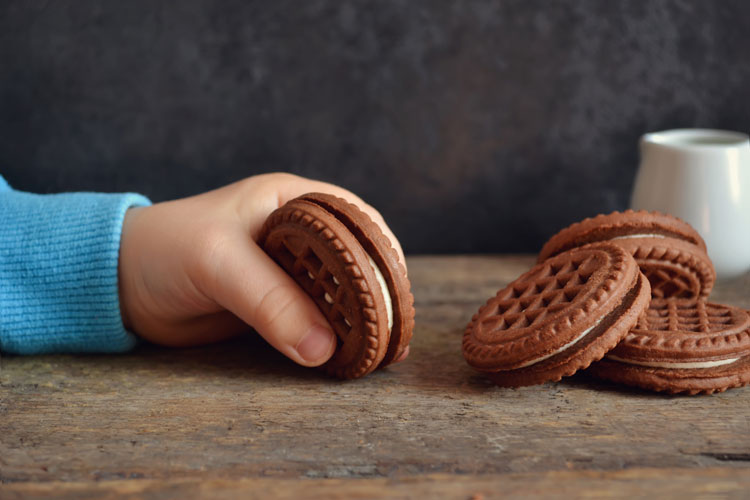These days, it’s common for researchers to conclude that “deficits” in children are what cause obesity. That is, there is something wrong with the child that leads to obesity. Self-control, generally defined as the ability to delay gratification, is a case in point. Self-control is also defined as the ability to control temper, respect others’ property, accept the ideas of peers’ and handle peer pressure.
According to some researchers, children who are low in self-control at the time they start school are said to be at risk for an unhealthy increase in BMI as they approach adolescence. These children who lack self-control eat fewer fruits and vegetables, drink more sugar sweetened beverages (SSB), and are less active. The logic behind these conclusions? That an unhealthy diet and activity behaviors provide more immediate gratification than healthy behaviors.
Giving children autonomy
In contrast, the Satter Feeding Dynamics Model emphasizes the importance of giving children autonomy in order for them to develop their “self-control” capabilities. These self-control capabilities are the ability to regulate food intake, grow predictably, and over time, learn to eat the variety of food to which they are regularly exposed in their every-day lives. Their parents give them autonomy, from birth, by following the division of responsibility in feeding and letting them determine how much they will eat from what parents offer. As they get older, parents give autonomy, by doing the what, when, and where of feeding, then letting children do the how much and whether of eating. This is positive self-control, growing out of inner capability and self-trust. This is in contrast to the usual definition of self-control, which is restraint and avoidance.
Developing trust
Toward the end of the first year, this positive self-control gradually becomes the ability to delay gratification. To gain the rewards of joining in with family meals and snacks, children have to wait to eat. After that brief wait, their needs are gratified: they get enough to eat of food they enjoy. As they grow up, they continue to behave autonomously: they eat “healthy” food and engage in “healthy” activity, not because someone else makes them or because they “should,” but because they enjoy it. They become ho-hum about sugar sweetened beverages and other high-sugar, high-fat foods from regular neutral exposure and therefore don’t consume them to excess. For example, children who are fed according to the division of responsibility learn that they will have the opportunity to eat treat foods every now and then and that they are offered at some meals together with other foods. They are then free to pick and choose from the treat and other foods as they wish. I have seen young children alternate between bites of a lamb cutlet in one hand and licks of an ice cream in the other. This is not self-control but knowing that their parents trust them to make those decisions, Read about feeding your child so that they grow to have the body they are meant to have: Your Child’s Weight: Helping without Harming


Beautiful. Thank you!
The psychologizing negatively.of plus-size children is so harmful to self-esteem.
Even as an adult, I feel affected by such negative assessments of larger kids.
Thank you for providing a healthier and more respectful perspective and feeding approach.
hello! can you make any suggestions for dealing with this issue with an older child (she’s 10) who is under the care of an endocrin who wants to delay puberty, so that growth hormones can continue?
help!
Hi Sara
In our review of the web, we find that some children just start puberty early (the articles say “too” early, but we say early). The only known cause to rule out is if a child has a tumor in the brain, ovary, or testicle. Otherwise, practitioners who take the intervention route test for sex hormone levels and try to force them down medically. We didn’t actually find anything saying the cause of early puberty is high body weight. But of course, when there is an esoteric condition, the medical folks seem to arrive at that conclusion sooner or later. There is a range of opinion on treat or don’t treat. As a baseline understanding, we learned in our physiology classes that the endocrine system is complex and intricately balanced and therefore one should be cautious in messing with it. However, precocious puberty is a diagnosible condition for which insurance pays. Which, for some practitioners, could weigh the balance in favor of intervene rather than wait-and-see. Hard for you to stay steady in the face of all of these unknowns. From our perspective, as long as your daughter grows consistently, we do not see her as being overweight. For us, that consistency is the bottom line.
How can to stop her father feeding my daughter high starch food she is already over wieght
Hi Kamella
Could you please ask your question via ‘Send Message’ on the Ellyn Satter Institute’s Facebook page: https://www.facebook.com/ellynsatterassociates/. Ellyn will see it there.
Thanks for contacting us.